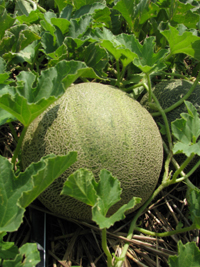(Rogers, Wszelaki, Blevins, Straw and Flaccavento)
Trap cropping is the planting of a ‘trap’ crop to protect the main cash crop from particular pests, by luring them into the trap. In our case, we are hoping to attract cucumber beetles away from the ‘Atlantis’ cantaloupe and ‘Dasher II’ cucumber cash crops and then manage those beetles with organically approved pesticides. In this system, pesticide use is reduced, as the area planted in trap crops is the only area that is treated with the pesticide and it is smaller than the area planted in cash crops. In small plantings, pests can be hand-picked or vacuumed from the trap crop.
Cucumber beetles can cause direct feeding damage to cucurbit plants, destroying stems, leaves and even the marketabiliy of fruit. Adult cucumber beetles also transmit bacterial wilt. Bacterial wilt, as the name implies, can cause the runners of plants to wilt and eventually die, leaving a field of unmarketable fruit.
Cucurbits produce compounds called cucurbitacins, which stimulate feeding of the Cucumber Beetles. Different cucurbit varieties produce different amounts of cucurbitacin, or attractant for the beetles. In this study, we will look at the attractiveness of six different trap crops: Blue Hubbard squash, Mini-red Turban squash, ‘Goldbar’ yellow straightneck squash, ‘Moonshine’ pumpkin, Green-striped Cushaw, ‘Diplomat’ Galia melon and cucumber and cantaloupe cash crop controls, to lure the beetles away from the cash crops. We will also look at movement of the beetles from crop to crop, proper timing and establishment of the trap crops, yield and damage to cash crops, and bacterial wilt incidence.
This project is a collaborative effort with Virginia Tech and Appalachian Sustainable Development, who received funding from the EPA to develop low-input and organic insect management systems.




